
The Egyptians pictured the world of 'yonder' in very concrete terms, covering not only life after death but also the world where the gods, and particularly the sun god, spent the night, that is, after the daily 'death' of the sun. As early as in the Pyramid Texts from the Old Kingdom an underworld is mentioned, called the Duat. In some texts it may be found in the (night) sky, with the inhabitants of Duat living as stars. The Pyramid Texts emphasize strongly that the hereafter is in the sky. The deceased is called upon to ascend to the sky on a ladder, in a cloud of dust or a whirlwind, as a locust, on or as a bird, etc. Nevertheless, the texts also speak of an underworld located beneath the earth's surface. The Egyptians did not consider these to be contradictory suggestions, but rather different ways of describing aspects of reality. From the Middle Kingdom on, depictions of the underworld became more concrete. Some sarcophagi even have complete maps of it drawn on their bottom boards. An even later elaboration appears in the funerary texts from the New Kingdom, such as the Amduat and the Book of Gates. These may be found in the tombs in the Valley of the Kings. The Amduat in particular (in Egyptian Imy(t)-Duat, 'that which is in the underworld') illustrates the regions through which the sun travels during the night, including their inhabitants. Sometimes actual measurements are given and, for example, the ominous noises in that world are described. By drawing parallels with the underworld, the dark rooms in tombs and temples, such as crypts, could be referred to with the term Duat. Finally, the Duat is also personified as a goddess, the mother who gives birth to the resurrected deceased.
Synonym: Duat